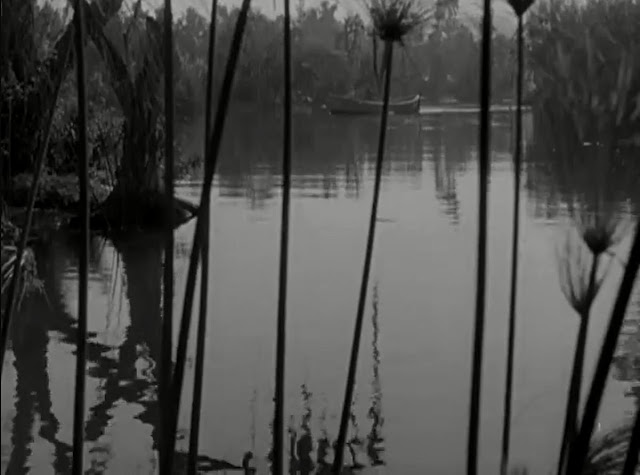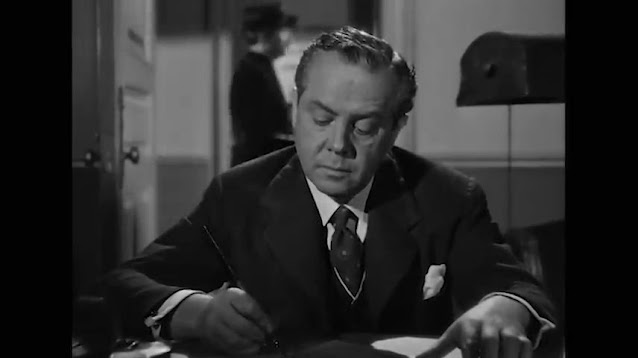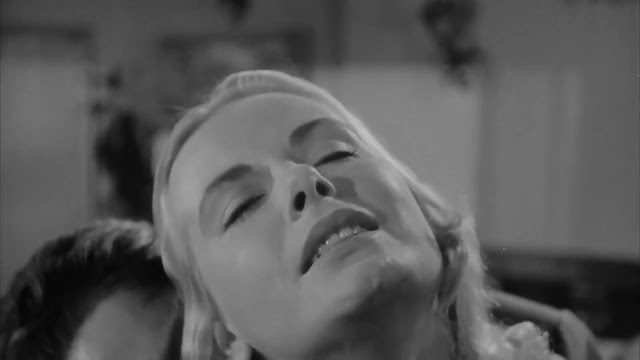When filming the cheapy Westerns he made early in his career, director Joseph H. Lewis used to tote around a box of wagon wheels. Whenever a scene was uninteresting, he'd plop down a wheel in the foreground and shoot through its spokes. The nickname this earned him, "Wagon Wheel Joe," was meant, at the time, as a put-down. In retrospect, it's emblematic of why Joseph H. Lewis should be a lot more widely respected than he is.
 |
| Lewis' wagon-wheels in action, from BORDER WOLVES (1938) |
Lewis was one of the great B-picture artists of Golden Age Hollywood. Working mostly on Poverty Row, he didn't let perfunctory stories, trite scripts, bad actors or budgets that more closely resembled the catering bill for A-pictures slow him down. Film is primarily a visual medium and if the other raw materials with which Lewis had to work were sometimes wanting, he could at least make the movies visually interesting. Those wagon wheels were just the beginning. Lewis rebelled against the traditional "invisible" Hollywood style, shooting, instead, tight, expressionistic cinema filled with unusual and inventive camera work--odd angles, odd staging, utterly individualistic. It's said to have driven his editors nuts but it often pepped up what would have otherwise been some forgettable--sometimes even awful--films, and made some better ones better yet.
Lewis cut his teeth on those cowboy quickies. He wasn't stuck with the shortest of short ends for long though. While he remained firmly ensconced in B-level productions for most of his career,[1] his budgets, his actors and his scripts did improve and soon, he wasn't just the only good thing about a bad movie.[2] With more resources with which to exercise his resourcefulness, he came into his own as a filmmaker and proceeded to make some damn good ones.
He usually tried to hook viewers early and was frequently very good at drawing in an audience with his first scene.[3] GUN CRAZY (1950) begins on an adolescent demonstrating an almost sexual attachment to a pistol in a store window. So overcome is he that he just can't resist breaking the glass and stealing it, only to immediately trip over his own feet and send the gun skittering across the rain-soaked street to come to a halt at the feet of a bystander revealed, as the camera moves up, to be a grim-faced policeman, who saw the whole thing. The pre-title sequence of TERROR IN A TEXAS TOWN (1958) is one of my favorites. There's Sterling Hayden playing a beefy Swedish whaler. He's marching through a Western town, totally out of place, with a crowd gathering behind him as he comes to a particular building and calls out some badman. The villain--in black, so we know he's a no-goodnik--has a gun on his hip but Hayden is hefting a harpoon on his shoulder as his weapon of choice. They're about to have it out and we cut from the scene to the opening credits.
 |
| Sterling Hayden--so tough he brings a harpoon to a gunfight. |
There's no way in hell anyone is going to watch that and not stick around for the rest of the movie. More subtle but also effective is the opening of MY NAME IS JULIA ROSS (1945), wherein we follow the lead character through the street in pouring rain, up to a rooming house then inside, where our heroine's situation is set up via a conversation with the housekeeper. Lewis doesn't let us go until we're into the picture.
Lewis had an affinity for close-ups and favored elaborate staging and long takes. Not static ones though. His camera is always on the move, always gliding from one set-up to another without cutting. He would sometimes even allow it to pass through apparently solid objects like windows. He set-ups are often expressionistic. In CRY OF THE HUNTED (1953), a lawman (Barry Sullivan) stuck in a swamp is trying to call to those searching for him but finds he has no voice--his POV is shot through a bank of reeds that look like prison bars set between himself and his would-be rescuers.
In SO DARK THE NIGHT (1946), a--what other kind could it be?--dark thought crosses the mind of a character sitting at a desk in a fully lit room; the lights abruptly dim, leaving only the characters' face illuminated from below in an extraordinarily sinister way. The thought quickly passes and the light in the room returns to normal--all of this one unbroken take.
Later in the same film, a heated fight is photographed through the flames of a fire.
Lewis had range. He shot a wide variety of films--melodramas, a war picture, spy pictures, period adventure, horror, musicals. For his last feature, he returned to the Western and gave us the aforementioned TERROR IN A TEXAS TOWN. Much more than just a run-of-the-mill oater, the film was an open challenge to the McCarthyism of the era, ghost-written by Dalton Trumbo and Lewis' friend Nedrick Young when both were still blacklisted. Making it was a bold move, and Lewis not only shot it but also cast Young as the villain. Shot with his usual flair, it's almost like an homage to his own earliest films.
Lewis's best work, however, was in film noir. ...JULIA ROSS and SO DARK... were solid, visually impressive efforts in the genre, while THE BIG COMBO (1955) was a genuine classic. It was also a bit notorious for one scene in which Richard Conte goes down on Jean Wallace. Conte is standing behind Wallace nuzzling her, telling he he'll give her anything she wants and drops down out of frame, as Lewis moves the camera into her face, which certainly gives away the game as the director holds the shot for a moment.
The scene initially got Lewis in hot water with the studio censors but, as he told it,[4] he turned the tables on them. Faced with their insistence that he'd shot a "filthy" scene, he professed not to understand what they were talking about. The intimation of oralism was utterly blatant but it didn't show anything. Apparently, the suggestion that they, themselves, had willfully chosen to interpret as "filthy" a scene the director (disingenuously) insisted was innocuous sufficiently embarrassed the Breen boys that they allowed it to remain in the film.
The flick for which Lewis is best remembered today though--the only one for which he's widely remembered--is GUN CRAZY. A directionless gun fetishist hooks up with a sexy, sharp-shooting sociopath, sparks of passion become a twisted obsession and soon the two are hard-charging down a path of self-delusion, robbery and murder that can only lead to their destruction, the whole of their rise and downward spiral sensationally photographed by Lewis's off-kilter camera. Easily Lewis's best picture and one of the best films noir of all time. Paul Schrader assesses that it's "one of the best American films ever made," or at least they quote him as saying so over on the Turner Classic Movies site. I certainly wouldn't characterize the assessment as hyperbole. The number of productions that have clipped from it would form a fairly sizable genre unto themselves.
Lewis has developed a cult following but that's as good as he's managed. Film nerds (like Shrader) dig him but he's a fairly obscure figure. Too obscure. His work deserves better than that, so this is my little contribution to getting it its due.
--j.
---
[1] The one exception I've seen is DESPERATE SEARCH (1952), which apparently had a much bigger budget than Lewis's other projects and also seemed to be an effort at a more "mainstream" film. Though not without its moments, the movie is, for the most part, depressingly average. Lewis ditches most of the visual flair of his other pictures and the result is the least interesting Lewis movie I've yet encountered.
[2] Since that sounds uncomfortably like an over-generalized knock on those "cowboy quickies," I'll go ahead and note that I'm a fan of both Lewis' early Westerns and the milieu in general and would certainly defend them against any accusation that they were merely disposable junk.
[3] In THE TYPEWRITER, THE RIFLE, AND THE MOVIE CAMERA, Jim Jarmusch recounting Sam Fuller's advice to him on screenwriting: "When you start your script, if the first page doesn't give you a hard-on, throw the goddamn thing away." Lewis seems to have had the same attitude. Lewis's brashness, his disregard for the conventional and the hook-'em-and-keep-'em tabloid aesthetic his films often radiate remind me of Fuller.
[4] On PBS's American Cinema series.












Fantastic post, just fascinating. So little is written on Lewis, and this sums up perfectly why he was such an important director in the history of film. Great stuff.
ReplyDeleteThanks; I do try. My life sort of fell apart after I wrote this piece, and I didn't have a lot of opportunity (or, after things fell in on me, the ability) to shop it around much, or engage in much discussion about it. I've been a Lewis admirer for a lot of years. When Turner Classic Movies ran a mini-marathon of his flicks (which can be quite hard to find), I decided it was past time I wrote something about them, and about him.
ReplyDeleteHope things are getting better for you. Keep writing - your stuff's too good for you not to!
ReplyDelete